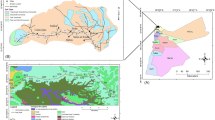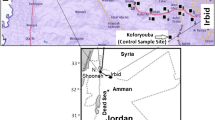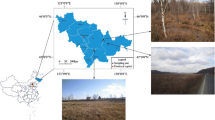Abstract
Traffic-related metal emissions have become a global concern due to their deposition in roadside soils and potential hazardous effects. This study evaluates metal levels in soils adjoining four highways of Rio de Janeiro (Linha Vermelha, Via Dutra, BR-465, and Avenida Brasil), chosen for their diverse traffic volumes, age, and urban/rural settings. In addition to soil physicochemical properties, 11 elements (Cd, Co, Cr, Cu, Fe, Mn, Ni, Pb, Sr, V, and Zn) were assessed on samples collected at different distances from the road (1, 3, 5, 10, 15 m) and soil depths (0–15 and 15–30 cm). Moreover, the geoaccumulation index was also computed to infer the soil contamination extent. The results indicate that soil metal levels at each highway are highly dependent on factors like traffic volume, distance to road, other anthropogenic sources of pollution, and their rural or urban location. The highways with greater traffic volume, Linha Vermelha and Avenida Brasil (154,000 and 126,000 vehicles day−1, respectively), clearly presented the highest soil metal concentrations. Still, as stressed by the principal component analysis, traffic volume alone fails to explain the distribution of metals in soils neighboring these highways. Thus, factors like their urban setting and larger exposure to anthropogenic activities may play a pivotal role. On the other hand, soils from Via Dutra and BR-465, both on a rural backdrop, were mostly influenced by traffic as their metal levels decreased with increasing distances from the road. Comparison with reference and preventive values for Brazilian soils and the assessment of the geoaccumulation index have shown that concentrations of Pb and V have reached concerning thresholds at Linha Vermelha and Avenida Brasil.




Similar content being viewed by others
References
Alloway, B. (2013). Heavy metals in soils. In B. J. Alloway (Ed.), Heavy metals in soils (Vol. Vol. 22). Dordrecht: Springer Netherlands. https://doi.org/10.1007/978-94-007-4470-7.
Aslam, J., Khan, S. A., & Khan, S. H. (2013). Heavy metals contamination in roadside soil near different traffic signals in Dubai, United Arab Emirates. Journal of Saudi Chemical Society, 17(3), 315–319. https://doi.org/10.1016/j.jscs.2011.04.015.
Basharat, Z., Novo, L., & Yasmin, A. (2018). Genome editing weds CRISPR: what is in it for phytoremediation? Plants, 7(3), 51. https://doi.org/10.3390/plants7030051.
Carvalho Filho, A., Lumbreras, J., Wittern, K., Lemos, A., Santos, R., Calderano Filho, S., et al. (2003). Mapa de reconhecimento de baixa intensidade dos solos do estado do Rio de Janeiro. Escala 1:250.000. Rio de Janeiro.
CETESB. (2014). Valores orientadores para solo e água subterrânea no estado de SP (Vol. 124). São Paulo.
Chen, X., Xia, X., Zhao, Y., & Zhang, P. (2010). Heavy metal concentrations in roadside soils and correlation with urban traffic in Beijing, China. Journal of Hazardous Materials, 181(1–3), 640–646. https://doi.org/10.1016/j.jhazmat.2010.05.060.
CONAMA.(2009) Resolução CONAMA No 420, de 28 de dezembro de 2009
COPAM. (2011). Deliberação Normativa no 166 - Valores orientadores para solos e água subterrânea. Conselho Estadual de Política Ambiental.
Davies, B. E. (1974). Loss-on-ignition as an estimate of soil organic matter. Soil Science Society of America Journal, 38, 150–151.
De Silva, S., Ball, A. S., Huynh, T., & Reichman, S. M. (2016). Metal accumulation in roadside soil in Melbourne, Australia: effect of road age, traffic density and vehicular speed. Environmental Pollution, 208, 102–109. https://doi.org/10.1016/j.envpol.2015.09.032.
Duong, T. T. T., & Lee, B. K. (2011). Determining contamination level of heavy metals in road dust from busy traffic areas with different characteristics. Journal of Environmental Management, 92(3), 554–562. https://doi.org/10.1016/j.jenvman.2010.09.010.
EPA 3051A. (2007). Method microwave assisted acid digestion of sediments, sludges, soils, and oils. USA: US environmental protection agency.
Faiz, Y., Tufail, M., Javed, M. T., & Chaudhry, M. M. (2009). Road dust pollution of Cd, Cu, Ni, Pb and Zn along Islamabad Expressway, Pakistan. Microchemical Journal, 92(2), 186–192. https://doi.org/10.1016/j.microc.2009.03.009.
FAO. (2015). World reference base for soil resources 2014 - update 2015. Rome. http://www.journals.cambridge.org/abstract_S0014479706394902
Guan, Z., Li, X. G., & Wang, L. (2018). Heavy metal enrichment in roadside soils in the eastern Tibetan Plateau. Environmental Science and Pollution Research, 25(8), 7625–7637. https://doi.org/10.1007/s11356-017-1094-8.
Hjortenkrans, D., Bergbäck, B., & Häggerud, A. (2006). New metal emission patterns in road traffic environments. Environmental Monitoring and Assessment, 117(1–3), 85–98. https://doi.org/10.1007/s10661-006-7706-2.
Hołtra, A., & Zamorska-Wojdyła, D. (2018). The input of trace elements from the motor transport into urban soils of Wrocław, Poland. Science of the Total Environment, 631–632, 1163–1174. https://doi.org/10.1016/j.scitotenv.2018.03.096.
Hooda, P. S., Miller, A., & Edwards, A. C. (2008). The plant availability of auto-cast platinum group elements. Environmental Geochemistry and Health, 30(2), 135–139. https://doi.org/10.1007/s10653-008-9134-4.
IBGE. (2017). Demographic estimates. Rio de Janeiro.
Jones, J. B. (2001). Laboratory guide for conducting soil tests and plant analysis. Boca Raton: CRC Press.
Kabata-Pendias, A. (2011). Trace elements in soils and plants (fourth.). In Boca Raton. Florida: CRC Press. https://doi.org/10.1201/b10158-25.
Kadi, M. W. (2009). “Soil pollution hazardous to environment”: a case study on the chemical composition and correlation to automobile traffic of the roadside soil of Jeddah city, Saudi Arabia. Journal of Hazardous Materials, 168(2–3), 1280–1283. https://doi.org/10.1016/j.jhazmat.2009.03.015.
Khan, M. N., Wasim, A. A., Sarwar, A., & Rasheed, M. F. (2011). Assessment of heavy metal toxicants in the roadside soil along the N-5, National Highway, Pakistan. Environmental Monitoring and Assessment, 182(1–4), 587–595. https://doi.org/10.1007/s10661-011-1899-8.
Kluge, B., & Wessolek, G. (2012). Heavy metal pattern and solute concentration in soils along the oldest highway of the world--the AVUS autobahn. Environmental Monitoring and Assessment, 184(11), 6469–6481. https://doi.org/10.1007/s10661-011-2433-8.
Kocher, B., Wessolek, G., & Stoffregen, H. (2005). Water and heavy metal transport in roadside soils. Pedosphere, 15(6), 746–753.
Li, H., Yu, S., Li, G., Deng, H., & Luo, X. (2011). Contamination and source differentiation of Pb in park soils along an urban–rural gradient in Shanghai. Environmental Pollution, 159(12), 3536–3544. https://doi.org/10.1016/j.envpol.2011.08.013.
Meuser, H. (2010a). Causes of soil contamination in the urban environment (Vol. 18, pp. 29–94). Dordrecht: Springer Netherlands. doi:https://doi.org/10.1007/978-90-481-9328-8_3.
Meuser, H. (2010b). Contamination influencing soil properties. In Contaminated urban soils (Vol. 18, pp. 195–242). Dordrecht: Springer Netherlands. doi:https://doi.org/10.1007/978-90-481-9328-8_6.
Müller, G. (1969). Index of geoaccumulation in sediments of the Rhine river. Geology Journal, 2, 108–118.
Nazzal, Y., Rosen, M. a., & Al-Rawabdeh, A. M. (2013). Assessment of metal pollution in urban road dusts from selected highways of the Greater Toronto Area in Canada. Environmental Monitoring and Assessment, 185(2), 1847–1858. https://doi.org/10.1007/s10661-012-2672-3.
Nordberg, G., Fowler, B. A., & Nordberg, M. (2015). Handbook on the toxicology of metals. (G. F. Nordberg, B. A. Fowler, & M. Nordberg, Eds.) (Fourth.). London: Academic Press. doi:https://doi.org/10.1016/C2011-0-07884-5.
Novo, L. A. B., Onishi, V. C., Bernardino, C. A. R., & da Silva, E. F. (2017). Metal bioaccumulation by plants in roadside soils: perspectives for bioindication and phytoremediation. In Enhancing cleanup of environmental pollutants (pp. 215–230). Cham: Springer International Publishing. https://doi.org/10.1007/978-3-319-55426-6_10.
Radziemska, M., & Fronczyk, J. (2015). Level and contamination assessment of soil along an expressway in an ecologically valuable area in Central Poland. International Journal of Environmental Research and Public Health, 12(10), 13372–13387. https://doi.org/10.3390/ijerph121013372.
Ribeiro, F. C. A., Lauria, D. d. C., Silva, J. I. R., Lima, E. S. A., Sobrinho, A., do, N. M. B., & Pérez, D. V. (2018). Baseline and quality reference values for natural radionuclides in soils of Rio de Janeiro state, Brazil. Revista Brasileira de Ciência do Solo, 42, 1–15. https://doi.org/10.1590/18069657rbcs20170146.
Riga-Karandinos, A. N., Saitanis, C. J., & Arapis, G. (2006). First study of anthropogenic platinum group elements in roadside top-soils in Athens, Greece. Water, Air, and Soil Pollution, 172(1–4), 3–20. https://doi.org/10.1007/s11270-005-9016-7.
Saeedi, M., Hosseinzadeh, M., Jamshidi, A., & Pajooheshfar, S. P. (2009). Assessment of heavy metals contamination and leaching characteristics in highway side soils, Iran. Environmental Monitoring and Assessment, 151(1–4), 231–241. https://doi.org/10.1007/s10661-008-0264-z.
Sezgin, N., Ozcan, H. K., Demir, G., Nemlioglu, S., & Bayat, C. (2004). Determination of heavy metal concentrations in street dusts in Istanbul E-5 highway. Environment International, 29(7), 979–985. https://doi.org/10.1016/S0160-4120(03)00075-8.
USDA Soil science division staff. (2017). Soil survey manual. (C. Ditzler, K. Scheffe, & H. C. Monger, Eds.). Washington, D.C.: USDA handbook 18. Government Printing Office.
Wawer, M., Magiera, T., Ojha, G., Appel, E., Kusza, G., Hu, S., & Basavaiah, N. (2015). Traffic-related pollutants in roadside soils of different countries in Europe and Asia. Water, Air, & Soil Pollution, 226(7), 216. https://doi.org/10.1007/s11270-015-2483-6.
Werkenthin, M., Kluge, B., & Wessolek, G. (2014). Metals in European roadside soils and soil solution – a review. Environmental Pollution, 189, 98–110. https://doi.org/10.1016/j.envpol.2014.02.025.
Yan, G., Mao, L., Liu, S., Mao, Y., Ye, H., Huang, T., Li, F., & Chen, L. (2018). Enrichment and sources of trace metals in roadside soils in Shanghai, China: a case study of two urban/rural roads. Science of the Total Environment, 631–632, 942–950. https://doi.org/10.1016/j.scitotenv.2018.02.340.
Yang, J., Zhang, C., & Tang, Y. (2015). Metal distribution in soils of an in-service urban parking lot. Environmental Monitoring and Assessment, 187(7), 478. https://doi.org/10.1007/s10661-015-4699-8.
Zhang, H., Zhang, Y., Wang, Z., Ding, M., Jiang, Y., & Xie, Z. (2016). Traffic-related metal(loid) status and uptake by dominant plants growing naturally in roadside soils in the Tibetan plateau, China. Science of the Total Environment, 573(11), 915–923. https://doi.org/10.1016/j.scitotenv.2016.08.128.
Funding
The authors would like to thank the funding agencies CNPq, CAPES, DAAD, and FAPERJ for the financial support and scholarships granted. Luís A. B. Novo acknowledges the support of the Portuguese Foundation for Science and Technology (FCT) under grant no. SFRH/BPD/103476/2014.
Author information
Authors and Affiliations
Corresponding author
Additional information
Publisher’s note
Springer Nature remains neutral with regard to jurisdictional claims in published maps and institutional affiliations.
Electronic supplementary material
ESM 1
(DOCX 67 kb)
Rights and permissions
About this article
Cite this article
Bernardino, C.A.R., Mahler, C.F., Santelli, R.E. et al. Metal accumulation in roadside soils of Rio de Janeiro, Brazil: impact of traffic volume, road age, and urbanization level. Environ Monit Assess 191, 156 (2019). https://doi.org/10.1007/s10661-019-7265-y
Received:
Accepted:
Published:
DOI: https://doi.org/10.1007/s10661-019-7265-y




